Pioneer EV-5DVD, EV-9DVD Manual

EV5DVD
Stereo DVD Cassette Deck Receiver
XV-EV5
Speaker System
S-EV5V
EV7DVD
Stereo DVD Cassette Deck Receiver
XV-EV7
Speaker System
S-EV7V
EV9DVD
Stereo DVD Cassette Deck Receiver
XV-EV9
Speaker System
S-EV9V
Operating Instructions
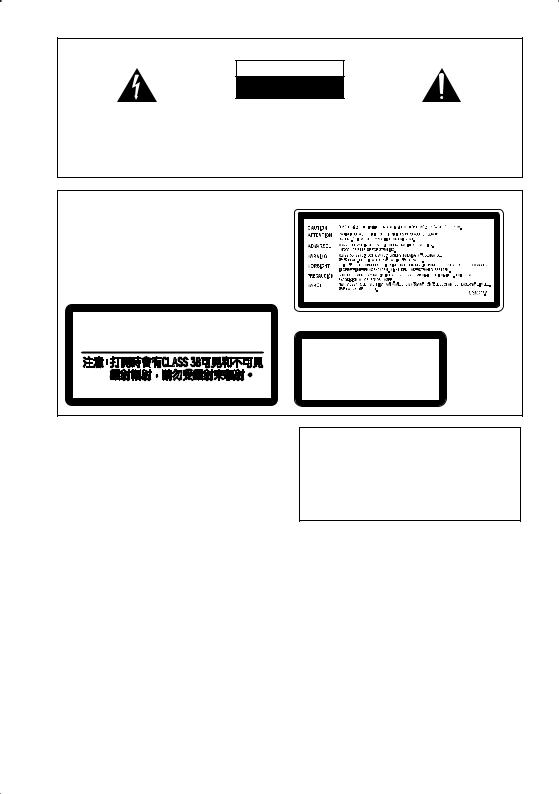
IMPORTANT
CAUTION
RISK OF ELECTRIC SHOCK
DO NOT OPEN
The lightning flash with arrowhead symbol, within an equilateral triangle, is intended to alert the user to the presence of uninsulated "dangerous voltage" within the product's enclosure that may be of sufficient magnitude to constitute a risk of electric shock to persons.
CAUTION:
TO PREVENT THE RISK OF ELECTRIC SHOCK, DO NOT REMOVE COVER (OR BACK). NO USER-SERVICEABLE PARTS INSIDE. REFER SERVICING TO QUALIFIED SERVICE PERSONNEL.
The exclamation point within an equilateral triangle is intended to alert the user to the presence of important operating and maintenance (servicing) instructions in the literature accompanying the appliance.
D3-4-2-1-1_En-A
CAUTION |
All other models |
This product is a class 1 laser product, but this product contains a laser diode higher than Class 1. To ensure continued safety, do not remove any covers or attempt to gain access to the inside of the product. Refer all servicing to qualified personnel.
The following caution label appears on your unit.
Location: bonnet of the unit
Taiwan model
CAUTION : CLASS 3B VISIBLE AND INVISIBLE LASER
RADIATION WHEN OPEN, AVOID
EXPOSURE TO THE BEAM.
VRW2159
Location: rear of the unit
CLASS 1
LASER PRODUCT
D3-4-2-1-8_A_En
WARNING
This equipment is not waterproof. To prevent a fire or shock hazard, do not place any container filed with liquid near this equipment (such as a vase or flower pot) or expose it to dripping, splashing, rain or moisture.
WARNING
Before plugging in for the first time, read the following section carefully.
The voltage of the available power supply differs according to country or region. Be sure that the power supply voltage of the area where this unit will be used meets the required voltage (e.g., 230 V or 120 V) written on the rear panel.
WARNING
To prevent a fire hazard, do not place any naked flame sources (such as a lighted candle) on the equipment.
Operating Environment
Operating environment temperature and humidity: +5 ºC to +35 ºC (+41 ºF to +95 ºF); less than 85 %RH (cooling vents not blocked)
Do not install this unit in a poorly ventilated area, or in locations exposed to high humidity or direct sunlight (or strong artificial light)
Recording equipment and copyright: Recording equipment should be used only for lawful copying and you are advised to check carefully what is lawful copying in the country in which you are making a copy. Copying of copyright material such as films or music is unlawful unless permitted by a legal exception or consented to by the rightowners.
K018_En
VENTILATION CAUTION
When installing this unit, make sure to leave space around the unit for ventilation to improve heat radiation (at least 30 cm at top, 15 cm at rear, and 15 cm at each side).
WARNING
Slots and openings in the cabinet are provided for ventilation to ensure reliable operation of the product, and to protect it from overheating. To prevent fire hazard, the openings should never be blocked or covered with items (such as newspapers, table-cloths, curtains) or by operating the equipment on thick carpet or a bed.
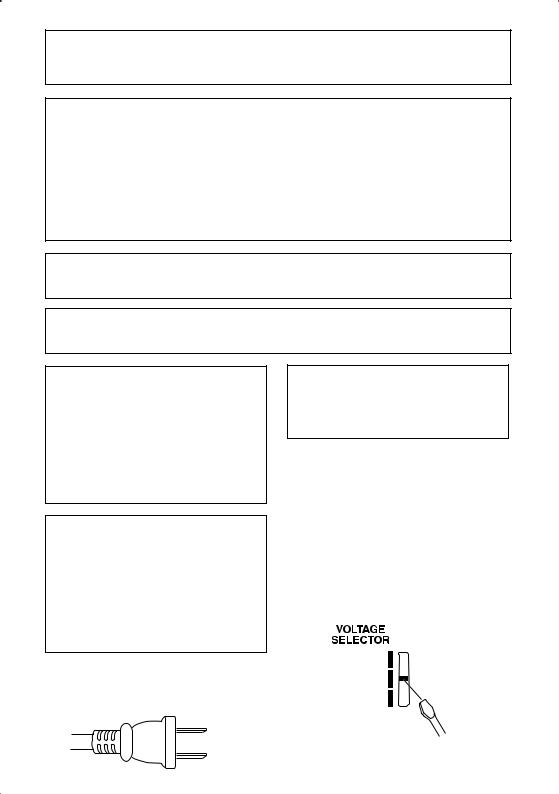
CAUTION : USE OF CONTROLS OR ADJUSTMENTS OR PERFORMANCE OF PROCEDURES OTHER THAN THOSE SPECIFIED HEREIN MAY RESULT IN HAZARDOUS RADIATION EXPOSURE.
CAUTION : THE USE OF OPTICAL INSTRUMENTS WITH THIS PRODUCT WILL INCREASE EYE HAZARD. D6-8-2-1_En
NOTE: This equipment has been tested and found to comply with the limits for a Class B digital device, pursuant to Part 15 of the FCC Rules. These limits are designed to provide reasonable protection against harmful interference in a residential installation. This equipment generates, uses, and can radiate radio frequency energy and, if not installed and used in accordance with the instructions, may cause harmful interference to radio communications. However, there is no guarantee that interference will not occur in a particular installation. If this equipment does cause harmful interference to radio or television reception, which can be determined by turning the equipment off and on, the user is encouraged to try to correct the interference by one or more of the following measures:
–Reorient or relocate the receiving antenna.
–Increase the separation between the equipment and receiver.
–Connect the equipment into an outlet on a circuit different from that to which the receiver is connected.
– Consult the dealer or an experienced radio/TV technician for help.
Information to User
D8-10-1-2_En
Alteration or modifications carried out without appropriate authorization may invalidate the user’s right to operate
the equipment. |
D8-10-2_En |
CAUTION: This product satisfies FCC regulations when shielded cables and connectors are used to connect the unit to other equipment. To prevent electromagnetic interference with electric appliances such as radios and televisions, use shielded cables and connectors for connections.
CAUTION
The STANDBY/ON switch on this unit will not completely shut off all power from the AC outlet. Since the power cord serves as the main disconnect device for the unit, you will need to unplug it from the AC outlet to shut down all power. Therefore, make sure the unit has been installed so that the power cord can be easily unplugged from the AC outlet in case of an accident. To avoid fire hazard, the power cord should also be unplugged from the AC outlet when left unused for a long period of time (for example, when on vacation).
If the AC plug of this unit does not match the AC outlet you want to use, the plug must be removed and appropriate one fitted. Replacement and mounting of an AC plug on the power supply cord of this unit should be performed only by qualified service personnel. If connected to an AC outlet, the cut-off plug can cause severe electrical shock. Make sure it is properly disposed of after removal.
The equipment should be disconnected by removing the mains plug from the wall socket when left unused for a long period of time (for example, when on vacation).
For Taiwan exclusively
Taiwanese two pin flat-bladed plug
This product is for general household purposes. Any failure due to use for other than household purposes (such as long-term use for business purposes in a restaurant or use in a car or ship) and which requires repair will be charged for even during the warranty period.
Voltage selector
You can find the voltage selector switch on the rear panel of multi-voltage models.
The factory setting for the voltage selector is 220 V to 230 V. Please set it to the correct voltage for your country or region.
•Saudi Arabia operates on 127 V and 220 V mains voltage. Please set to the correct voltage before using.
•For Taiwan, please set to 110 V to 127 V before using.
•For Mexico, please set to 110 V to 127 V before using.
Before changing the voltage, disconnect the AC power cord. Use a medium size screwdriver to change the voltage selector switch.
110V –
127V
220V –
230V
240V
Medium size screwdriver
D3-4-2-1-5_En

Thank you for buying this Pioneer product.
Please read through these operating instructions so that you will know how to operate your model properly. After you have finished reading the instructions, put them in a safe place for future reference.
Contents
01 Before you start
Checking what’s in the box . . . . . . . . . . . . . . . 6
Loading the batteries . . . . . . . . . . . . . . . . . . . 6
Range of the remote control unit . . . . . . . . . . 6 Attaching the non-skid pads . . . . . . . . . . . . . . 7 Removing the speaker grilles . . . . . . . . . . . . 7
02 Connecting up
Connecting the speaker terminals . . . . . . . . . 8 Multichannel speaker connections . . . . . . . . . 9 Hints on speaker placement. . . . . . . . . . . . . 9
Attaching the surround speakers to the speaker stands . . . . . . . . . . . . . . . . . . . . . . 10
Optional surround speaker connections . . . . 10 Connecting the radio antennas. . . . . . . . . . . 10 Connecting external antennas . . . . . . . . . . 11
Connecting to your TV. . . . . . . . . . . . . . . . . . 11
Connecting using the component
video output . . . . . . . . . . . . . . . . . . . . . . . . 11
Connecting auxiliary components. . . . . . . . . 12
Connecting the power. . . . . . . . . . . . . . . . . . 12
03 Controls and displays
Front panel . . . . . . . . . . . . . . . . . . . . . . . . . . 13 Display . . . . . . . . . . . . . . . . . . . . . . . . . . . . . 14 Remote control . . . . . . . . . . . . . . . . . . . . . . . 15
04 Getting started
Setting the clock . . . . . . . . . . . . . . . . . . . . . . 17
Using the remote to control your TV . . . . . . . 17 Using the on-screen displays . . . . . . . . . . . . 17
Playing discs . . . . . . . . . . . . . . . . . . . . . . . . 18
Basic playback controls . . . . . . . . . . . . . . . 18 Resume and Last Memory . . . . . . . . . . . . . 19 DVD-Video disc menus. . . . . . . . . . . . . . . . 19 Video CD/Super VCD PBC menus . . . . . . . 19
Listening to the radio . . . . . . . . . . . . . . . . . . 20
Improving FM stereo sound . . . . . . . . . . . . 20 Listening to other sources . . . . . . . . . . . . . . 20
Dimming the display. . . . . . . . . . . . . . . . . . . 20
05 Setting up for surround sound
Home theater sound setup . . . . . . . . . . . . . . 21 Setting the channel levels . . . . . . . . . . . . . 21
06 Home theater sound
About the listening modes . . . . . . . . . . . . . . 23
Auto listening mode . . . . . . . . . . . . . . . . . . . 23
Listening in surround sound . . . . . . . . . . . . . 23
Using Front Surround . . . . . . . . . . . . . . . . . . 24
Using the Extra Power mode. . . . . . . . . . . . 24
Listening in stereo . . . . . . . . . . . . . . . . . . . . . 24
Listening with headphones . . . . . . . . . . . . . . 24
07 Disc playback features
Scanning discs . . . . . . . . . . . . . . . . . . . . . . . 25
Playing in slow motion . . . . . . . . . . . . . . . . . 25 Frame advance/frame reverse . . . . . . . . . . . . 25 Playing a JPEG slideshow . . . . . . . . . . . . . . . 25 Browsing DVD or Video CD/Super VCD discs with the Disc Navigator . . . . . . . . . . . . . . . . . 26 Browsing WMA, MP3, MPEG-4 AAC,
DivX video and JPEG files with the
Disc Navigator. . . . . . . . . . . . . . . . . . . . . . . . 27
Looping a section of a disc . . . . . . . . . . . . . . 27
Using repeat play . . . . . . . . . . . . . . . . . . . . . 27 Using random play . . . . . . . . . . . . . . . . . . . . 28
Creating a program list . . . . . . . . . . . . . . . . . 28
Using the OSD . . . . . . . . . . . . . . . . . . . . . . 28
Other functions available from the
program menu . . . . . . . . . . . . . . . . . . . . . . 29
Using the front panel display . . . . . . . . . . . 29
Using Playlists. . . . . . . . . . . . . . . . . . . . . . . . 29
Programming playlists . . . . . . . . . . . . . . . . 29 Listening to playlists . . . . . . . . . . . . . . . . . . 30 Clearing files from a playlist . . . . . . . . . . . . 30
Searching a disc . . . . . . . . . . . . . . . . . . . . . . 30 Switching subtitles . . . . . . . . . . . . . . . . . . . . 30
Switching language / audio channels . . . . . . 31
Zooming the screen . . . . . . . . . . . . . . . . . . . 31
Switching camera angles . . . . . . . . . . . . . . . 31 Displaying disc information. . . . . . . . . . . . . . 31
08 USB playback
Using the USB interface . . . . . . . . . . . . . . . . 32 Basic playback controls . . . . . . . . . . . . . . . . 32
Scanning files . . . . . . . . . . . . . . . . . . . . . . . . 33
Playing a JPEG slideshow . . . . . . . . . . . . . . . 33 Browsing files with the Navigator . . . . . . . . . 33
4
En

09 Using the tape deck
Playing cassette tapes. . . . . . . . . . . . . . . . . . 34 Basic playback controls . . . . . . . . . . . . . . . 34 Making tape recordings. . . . . . . . . . . . . . . . . 35 Automatically recording CDs (ASES). . . . . . . 35
10 More tuner features
Memorizing stations . . . . . . . . . . . . . . . . . . . 37
Manually saving station presets . . . . . . . . . 37 Automatically saving station presets . . . . . 37 Listening to station presets . . . . . . . . . . . . . 37
11 Singing karaoke
Singing karaoke . . . . . . . . . . . . . . . . . . . . . . 38
Changing the vocal mix . . . . . . . . . . . . . . . 38 Changing the backing track . . . . . . . . . . . . 38
12 Adjusting the sound
Using the Sound menu . . . . . . . . . . . . . . . . . 39
Using the Sound Field Control. . . . . . . . . . . . 39 Boosting the bass level . . . . . . . . . . . . . . . . . 39
Muting the sound . . . . . . . . . . . . . . . . . . . . . 39
13 Using the timer
Setting the wake-up timer . . . . . . . . . . . . . . . 40 Turning the wake-up timer on/off . . . . . . . . 40 Setting the sleep timer . . . . . . . . . . . . . . . . . 40 Setting the record timer . . . . . . . . . . . . . . . . 41 Turning the record timer on/off . . . . . . . . . . 41
14 Audio Settings and Video Adjust menu
Audio Settings menu. . . . . . . . . . . . . . . . . . . 42 Audio DRC . . . . . . . . . . . . . . . . . . . . . . . . . 42 Virtual Surround . . . . . . . . . . . . . . . . . . . . . 42 Video Adjust menu . . . . . . . . . . . . . . . . . . . . 42
15 Initial Settings menu
Using the Initial Settings menu . . . . . . . . . . . 44 Video Output settings . . . . . . . . . . . . . . . . . 44
Language settings . . . . . . . . . . . . . . . . . . . 44 Display settings . . . . . . . . . . . . . . . . . . . . . 45 Options settings . . . . . . . . . . . . . . . . . . . . . 45 Parental Lock . . . . . . . . . . . . . . . . . . . . . . . 45
About DivX® VOD content . . . . . . . . . . . . . 46
Speaker Distance . . . . . . . . . . . . . . . . . . . . 47
16 Additional information
Optional system settings . . . . . . . . . . . . . . . . 48 System Setup menu options in standby . . . 48
Disc / content format playback
compatibility . . . . . . . . . . . . . . . . . . . . . . . . . 49
Disc compatibility table . . . . . . . . . . . . . . . . 50 About DVD+R/DVD+RW compatibility. . . . 50
About DivX . . . . . . . . . . . . . . . . . . . . . . . . . 50 About MPEG-4 AAC. . . . . . . . . . . . . . . . . . . 51 About WMA. . . . . . . . . . . . . . . . . . . . . . . . . 51
Using and taking care of discs. . . . . . . . . . . . 52
DVD Video regions . . . . . . . . . . . . . . . . . . . 52 Handling discs . . . . . . . . . . . . . . . . . . . . . . 52 Storing discs . . . . . . . . . . . . . . . . . . . . . . . . 52 Discs to avoid . . . . . . . . . . . . . . . . . . . . . . . 52 Using cassette tapes . . . . . . . . . . . . . . . . . . . 52
Tapes you should avoid . . . . . . . . . . . . . . . . 52 Protecting your recordings . . . . . . . . . . . . . 52 Installation and maintenance . . . . . . . . . . . . 53
Hints on installation . . . . . . . . . . . . . . . . . . 53
Cleaning the pickup lens . . . . . . . . . . . . . . . 53 Problems with condensation . . . . . . . . . . . . 53 Moving the system unit . . . . . . . . . . . . . . . . 53 Screen sizes and disc formats . . . . . . . . . . . . 54
Resetting the system . . . . . . . . . . . . . . . . . . . 54 Troubleshooting . . . . . . . . . . . . . . . . . . . . . . . 55 General . . . . . . . . . . . . . . . . . . . . . . . . . . . . 55
DVD/CD/Video CD player. . . . . . . . . . . . . . . 56 WMA/MP3/MPEG-4 AAC/JPEG discs . . . . . 57
Tuner. . . . . . . . . . . . . . . . . . . . . . . . . . . . . . 57 USB connection . . . . . . . . . . . . . . . . . . . . . 57 Tape deck . . . . . . . . . . . . . . . . . . . . . . . . . . 58 Error Messages . . . . . . . . . . . . . . . . . . . . . . 58
Using the language code list . . . . . . . . . . . . . 58
Language code list. . . . . . . . . . . . . . . . . . . . . 59
Country/Area code list . . . . . . . . . . . . . . . . . . 59
Preset code list . . . . . . . . . . . . . . . . . . . . . . . 60 Specifications . . . . . . . . . . . . . . . . . . . . . . . . 60
5
En
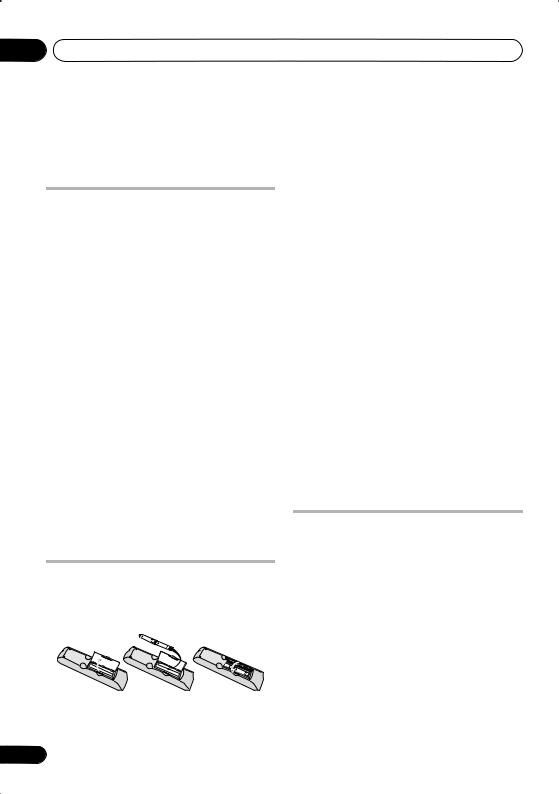
01 Before you start
Chapter 1
Before you start
Checking what’s in the box
Please check that you've received the following supplied accessories:
•Remote control
•Dry cell batteries (AA/R6) x2
•Video cord
•AM loop antenna
•FM antenna
•Power cord:
Central and South American, Taiwan, Philippines models x2
All other models x1
•Speaker cords x1 (S-EV9V only)
•Speaker stands x2 (S-EV7V only)
•Non-skid pads x12 (S-EV7V only) / x4 (S- EV9V only)
•Power plug adapter (Central and South American, US Military and Duty Free models only)
•Warranty Card (US Military and Duty Free models only)
•These operating instructions
 Important
Important
Incorrect use of batteries may result in such hazards as leakage and bursting. Observe the following precautions:
•Never use new and old batteries together.
•Insert the plus and minus sides of the batteries properly according to the marks in the battery case.
•Batteries with the same shape may have different voltages. Do not use different batteries together.
•When disposing of used batteries, please comply with governmental regulations or environmental public instruction’s rules that apply in your country or area.
•Do not use or store batteries in direct sunlight or other excessively hot place, such as inside a car or near a heater. This can cause batteries to leak, overheat, explode or catch fire. It can also reduce the life or performance of batteries.
Range of the remote control unit
The remote control has a range of about 7 meters (23 ft). It may not work properly if:
Loading the batteries
Use AA/R6 batteries with the supplied remote control. Make sure to follow the indications ( ,
) inside the compartment.
•There are obstacles between the remote control and this unit’s remote sensor.
•Direct sunlight or fluorescent light is shining onto the remote sensor.
•This system is located near a device that is emitting infrared rays.
•This unit is operated simultaneously with another infrared remote control unit.
6
En

Before you start |
01 |
Attaching the non-skid pads
EV7DVD/EV9DVD model only
Use the self-adhesive non-skid pads to provide a stable base for the speakers. Attach four to each speaker or stand as shown below.
Center speaker |
Surround speaker |
|
(EV7DVD only) |
EV7DVD only – If you choose to use the Front surround 3-spot setup (as explained in Home theater sound setup on page 21), we recommend using the speaker stands provided (instead of attaching the pads to the base of the surround speakers). Using the speaker stands for the Standard surround 5-spot setup is optional. See Attaching the surround speakers to the speaker stands on page 10 for more on this.
Speaker stands
Removing the speaker grilles
If necessary, remove the front and (EV9DVD only) surround speaker grilles as described below.
1Gently ease the grille loose by gripping the bottom and pulling towards you.
2Pull the top free in the same way.
When reattaching, start from the top then push the bottom in until secure.
•It is not recommended (due to dirt and dust) to leave the speaker grilles removed.
•Do not install your speakers overhead on the ceiling or wall. If improperly attached, the speaker grille can fall and cause damage or personal injury.
English
Español Nederlands Italiano Français Deutsch
7
En
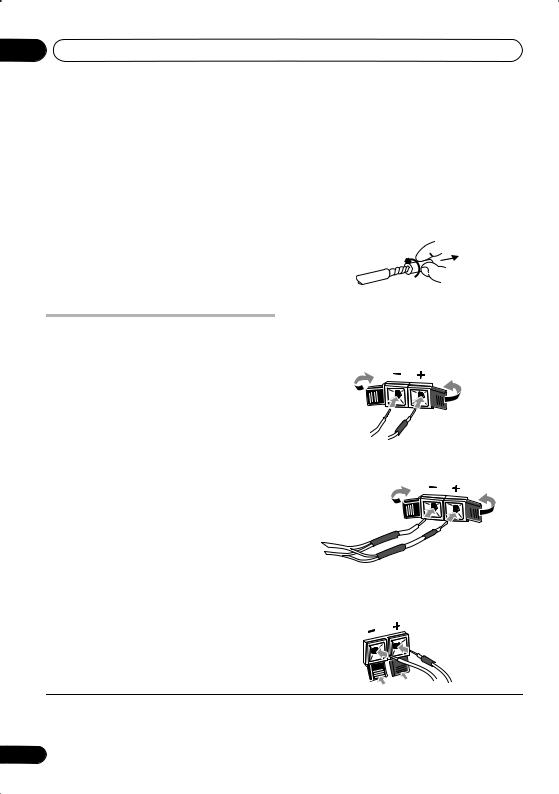
02 Connecting up
Chapter 2
Connecting up
 Important
Important
•Before making or changing any connections, switch off the power and unplug the power cord from the AC outlet.
•When making cable connections, make sure not to bend the cables over the top of this unit. This may cause a humming noise from the speakers.
Connecting the speaker terminals
Connect the wires from the speakers to the terminals on the main unit rear panel as shown below. Before connecting, you may want to consider the placement options available in
your room, and when using this system:1
•EV5DVD model only – Place the front left and right speakers at equal distances from the TV, then connect them as shown below. See Optional surround speaker connections on page 10 to connect surround speakers.
•EV7DVD/EV9DVD model only – A color-coded system is provided for speaker connections (see Multichannel speaker connections below). See Home theater sound setup on page 21 for surround placement options.
 Caution
Caution
•Do not connect this speaker to any amplifier other than the one supplied with this system. Connection to any other amplifier may result in a malfunction or fire.
•Make sure that the bare speaker wires cannot touch each other, or come into contact with other metal parts once the unit is switched on.
1Twist and pull off the protective shields on each wire.
2Connect to the speaker terminals on the rear of the unit.
Make sure to insert the red/colored wire into the red/colored (+) tab and the black/white wire into the black (–) tab.
•EV9DVD only – Connect the single end of the Y-cable to the SUB WOOFER terminal.
 Y-cable
Y-cable
(EV9DVD only)
3 EV9DVD only: With the dual end of the Y- cable, connect to the rear of each subwoofer in the same way.
 Note
Note
1 The speakers supplied with this system are magnetically shielded (except for the surround speakers, which should not be placed near a TV or monitor). However, placing them extremely close to a television may result in color distortion on the screen. If this happens, move the speakers a little further away and switch off the television for 15 to 30 minutes.
8
En
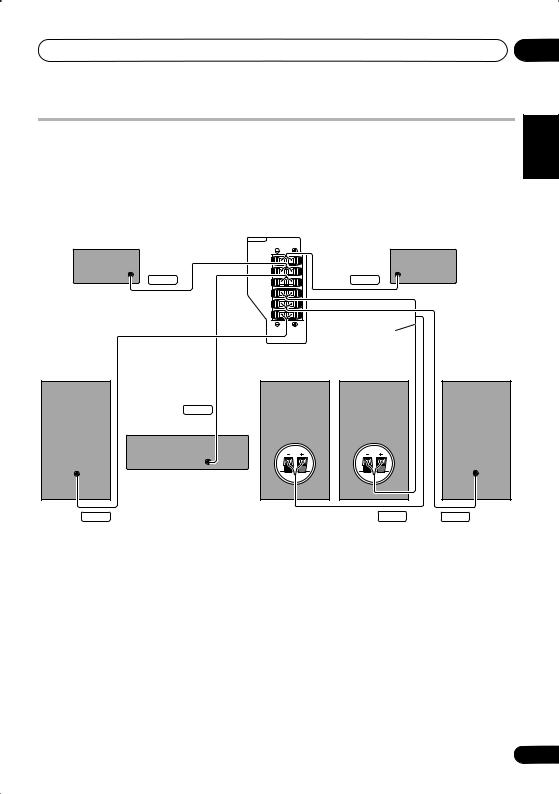
Connecting up
Multichannel speaker connections
EV7DVD/EV9DVD model only
Connect each speaker using the color-coded speaker cable. Match them to the colored labels above the speaker terminals (see illustration below).
•EV9DVD model only – Since there is only one terminal to connect the two subwoofers, you will need to use the supplied Y-cable for the connection.
|
EV7DVD/EV9DVD |
|
Surround right |
SPEAKERS |
Surround left |
|
||
|
L |
|
|
SURROUND |
|
|
R |
|
Gray |
CENTER |
Blue |
|
|
|
|
SUB WOOFER |
|
|
L |
|
|
FRONT |
|
|
R |
|
|
|
EV9DVD – Y-cable |
EV7DVD – Single cable (no speaker terminal on subwoofer)
|
Subwoofer |
|
|
Front right |
(EV9DVD only) |
Subwoofer |
Front left |
|
Green |
|
|
|
Center |
|
|
02
English
Nederlands Italiano Français Deutsch
Red
Hints on speaker placement
The following guidelines will help you to get the best performance from your speaker system. See Home theater sound setup on page 21 for surround placement options with this system.
•Place the front left and right speakers at equal distances from the TV.
•Place the center speaker above or below the TV so that the sound of the center channel is localized at the TV screen.
•If possible, place the surround speakers slightly above ear level.
Purple White
 Caution
Caution
•These speaker terminals carry
HAZARDOUS LIVE VOLTAGE. To prevent the risk of electric shock when connecting or disconnecting the speaker cables, disconnect the power cord before touching any uninsulated parts.
•If you choose to install the center speaker on top of the TV, be sure to secure it with putty, or by other suitable means, to reduce the risk of damage or injury resulting from the speaker falling from the TV in the event of external shocks such as earthquakes.
Español
9
En
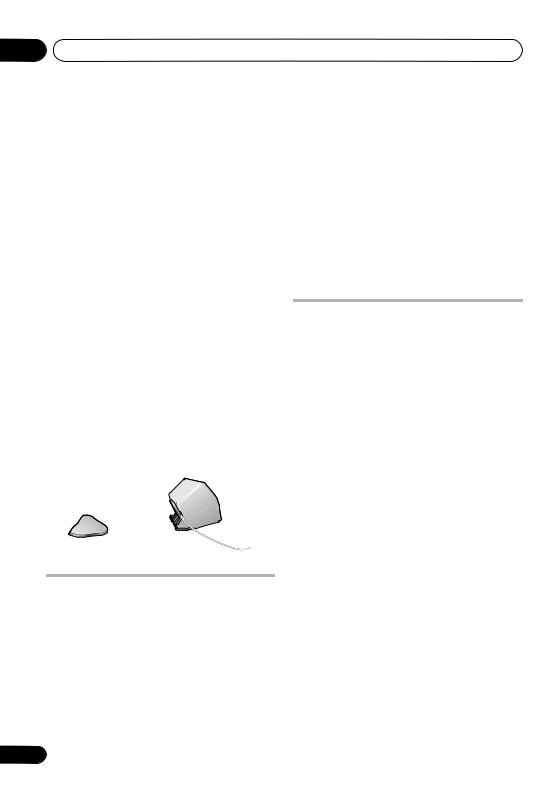
02 Connecting up
•Try not to place the surround speakers further away from the listening position than the front and center speakers. Doing so can weaken the surround sound effect.
•Make sure all speakers are installed securely to prevent accidents and improve sound quality.
•Do not attach these speakers to the wall or ceiling. They may fall off and cause injury.
Attaching the surround speakers to the speaker stands
EV7DVD model only
If you have set up your system using the Front surround 3-spot setup (as explained in Home theater sound setup on page 21), it is necessary to use the speaker stands provided. Using the speaker stands for the Standard surround 5- spot setup is optional. Attach each speaker as shown in the steps below.
1 Line up the spurs on the speaker stand with the holes on the back of the surround speaker and press into place.
2 With the spurs fixed in place, pull the speaker downward to secure it on the stand.
1 |
2 |
Optional surround speaker connections
EV5DVD model only
Using RCA speaker cables, you can connect surround speakers to the left and right SURROUND speaker jacks on the rear panel for multichannel sound from this system.
For the best surround effect, place the surround speakers slightly above ear level and at the same distance from the listening position as the front speakers.
10
 Important
Important
•Use speakers with a nominal impedance of at least 16 Ω.
•Make sure you connect both surround speakers or you won’t be able to hear anything from the surround jacks.
R
L
SURROUND
Connecting the radio antennas
Connecting the supplied antennas will allow you to listen to both AM and FM radio broadcasts. If you find that reception quality is poor, an outdoor antenna should give you better sound quality—see Connecting external antennas below for more on how to do this.
fig. a |
fig. b |
fig. c |
ANTENNA
AM LOOP
ANTENNA
5
FM
UNBAL
75Ω
4
1 

 2
2

3
En

Connecting up |
02 |
1Pull off the protective shields of both AM antenna wires.
2Push open the tabs, then insert one wire fully into each terminal, then release the tabs to secure the AM antenna wires.
3Fix the AM loop antenna to the stand.
To fix the stand to the antenna, bend in the direction indicated by the arrow (fig. a) then clip the loop onto the stand (fig. b).
•If you plan to mount the AM antenna to a wall or other surface, secure the stand with screws (fig. c) before clipping the loop to the stand. Make sure the reception is clear.
4Place the AM antenna on a flat surface and point in the direction giving the best reception.
Don’t let it come into contact with metal objects and avoid placing near computers,
television sets or other electrical appliances.1
5 Connect the FM wire antenna in the same way as the AM loop antenna.
For best results, extend the FM antenna fully and fix to a wall or door frame. Don’t drape loosely or leave coiled up.
External FM antenna
Use a PAL connector to hook up an external FM antenna.
ANTENNA |
|
AM LOOP |
PAL connector |
ANTENNA |
|
FM |
|
UNBAL |
|
75Ω |
|
Connecting to your TV
This system offers three types of video connections. If your TV has component video inputs, see Connecting using the component video output below.
1 Use the supplied yellow video cable to connect the VIDEO OUT jack to a video input on your TV.
VIDEO
OUT 
2 Optionally: Use a stereo audio cable to Connecting external antennas connect the audio outs of your TV (or VCR) to
the LINE IN jacks on the rear of this unit.
External AM antenna
Use 5 to 6 meters of vinyl-insulated wire and set up either indoors or outdoors. Leave the AM loop antenna connected.
Outdoor antenna
Indoor
ANTENNA
antenna
AM LOOP
(vinyl-coated |
ANTENNA |
wire) |
5 m to 6 m |
|
FM |
|
UNBAL |
|
75Ω |
This will enable you to hear the TV (or VCR) sound through this system. See Connecting auxiliary components below for more on this.
Connecting using the component video output
If your TV has component video inputs, you can use these instead of the standard video output
to connect this system to your TV.2 This should give you the best quality picture from the three types of video output available.
|
|
Note |
1 |
|
The signal ground ( ) is designed to reduce noise that occurs when an antenna is connected. It is not an electrical safety |
ground. |
||
2 |
The component video output is switchable between interlaced and progressive formats. See Video Output settings on page 44. |
|
English
Español Nederlands Italiano Français Deutsch
11
En
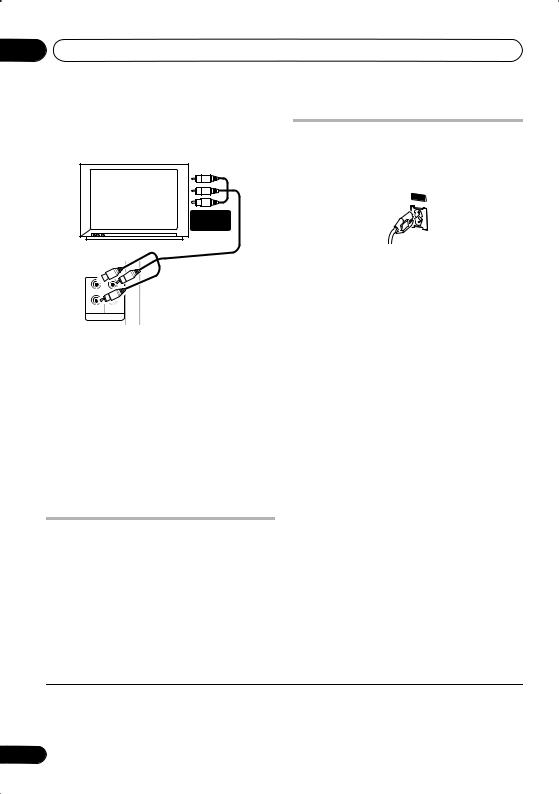
02Connecting up
•Use a component video cable to connect the COMPONENT VIDEO OUT to a set of component inputs on your TV.
COMPONENT
INPUT
PB  PR
PR
YVIDEO OUT
COMPONENT VIDEO OUT
About progressive scan video
Compared to interlace video, progressive scan video effectively doubles the scanning rate of the picture, resulting in a very stable, flickerfree image. Progressive scan video is available only from the component video output.
Compatibility of this player with progressive-scan and high-definition TVs.
This player is compatible with progressive video Macro Vision System Copy Guard.1
Connecting the power
After making sure that everything is connected properly, plug in the power cord to the AC inlet, and the other end to a mains power outlet.
AC IN
Congratulations! You’re done setting up.
POWER-CORD CAUTION
Handle the power cord by the plug. Do not pull out the plug by tugging the cord and never touch the power cord when your hands are wet as this could cause a short circuit or electric shock. Do not place the unit, a piece of furniture, etc., on the power cord, or pinch the cord. Never make a knot in the cord or tie it with other cords. The power cords should be routed such that they are not likely to be stepped on. A damaged power cord can cause a fire or give you an electrical shock. Check the power cord once in a while. When you find it damaged, ask your nearest PIONEER authorized service center or your dealer for a replacement.
Connecting auxiliary components
This system has stereo analog inputs which you can use to connect external components, such as a VCR, MD player, or your TV.
• Connect the LINE IN jacks on the rear panel to an auxiliary playback component.
Connect using RCA pin-plug stereo cables.
 Note
Note
1 Consumers should note that not all high-definition television sets are fully compatible with this product and may cause artifacts to be displayed in the picture. In case of 525 progressive scan picture problems, it is recommended that the user switch the connection to the ‘standard definition’ output (Interlace). If there are questions regarding our TV set compatibility with this model, please contact our customer service center.
12
En
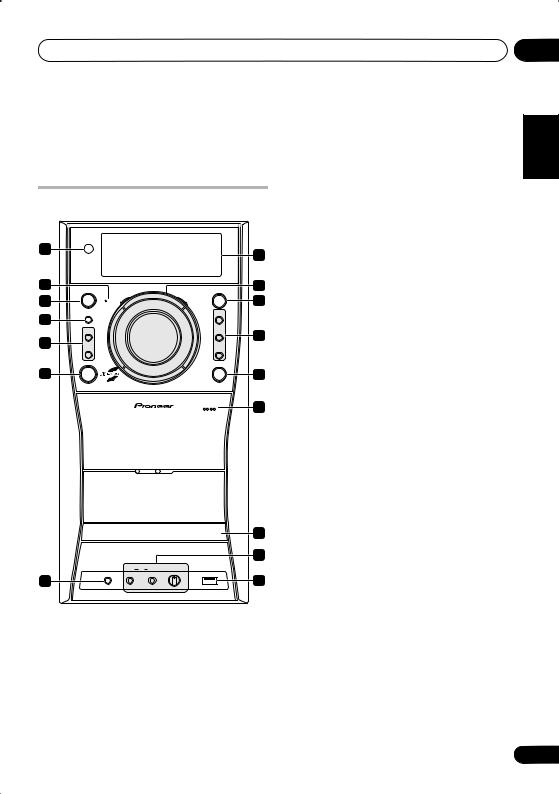
Controls and displays
Chapter 3
Controls and displays
Front panel
1 |
|
|
|
|
8 |
|
|
|
|
|
|
2 |
STANDBY/ON |
VOLUME− |
VOLUME+ |
FUNCTION |
9 |
3 |
|
10 |
|||
|
TIMER |
|
|
||
|
ENTER |
|
|
PLAY |
|
4 |
|
|
LIST 1 |
|
|
|
|
|
|
|
|
|
ASES |
|
|
PLAY |
11 |
|
|
|
LIST 2 |
||
5 |
MS–/REW |
|
|
MS+/FF |
|
TUNING− |
|
|
TUNING |
|
|
|
|
|
PLAY |
|
|
|
REC/STOP |
|
|
LIST 3 |
|
|
|
|
|
DVD |
|
|
|
|
|
OPEN/CLOSE |
|
6 |
|
|
|
|
12 |
|
|
|
|
PUSH OPEN |
13 |
|
|
|
14 |
|
|
|
15 |
PHONES |
SUB MIC MAIN |
MIC |
USB |
VOL |
|||
7 |
MIN |
MAX |
16 |
1Remote sensor
2TIMER indicator
Lights when the timer has been set (page 40).
3 STANDBY/ON
Switches the player on or into standby.
4 ENTER
Selects options or executes commands.
5Tape cassette controls
ASES – Press for CD-to-tape synchro recording (page 35).
REC/STOP – Starts/stops recording on the tape deck (page 35).
6X.BOOM button
Switches on the bass boost (page 39).
7PHONES jack
Headphone jack.
8Display
See Display below.
9Tuning/playback controls / Volume dial / X.BOOM LED
The tuning/scan/skip buttons are used for tuning into stations, skipping or scanning tracks on discs or tapes. The playback control buttons are used for playing, pausing and stopping playback. The volume dial adjusts the volume level. The X.BOOM LED lights to show the current bass boost setting (page 39).
10FUNCTION
Selects the source you want to listen to.
11 PLAY LIST buttons
Adds tracks to (during playback), or selects the playlist (while stopped) (page 29).
12DVD OPEN/CLOSE
Opens / closes the disc tray.
13PUSH OPEN
Pressing down on this side on the cassette door will open the tape deck.
14Disc tray
15MIC VOL and MIC input jacks
Controls the volume of the karaoke mics (MAIN and SUB) (page 38).
16USB interface
Connect a USB device for playback (see USB playback on page 32).
03
English
Español Nederlands Italiano Français Deutsch
13
En
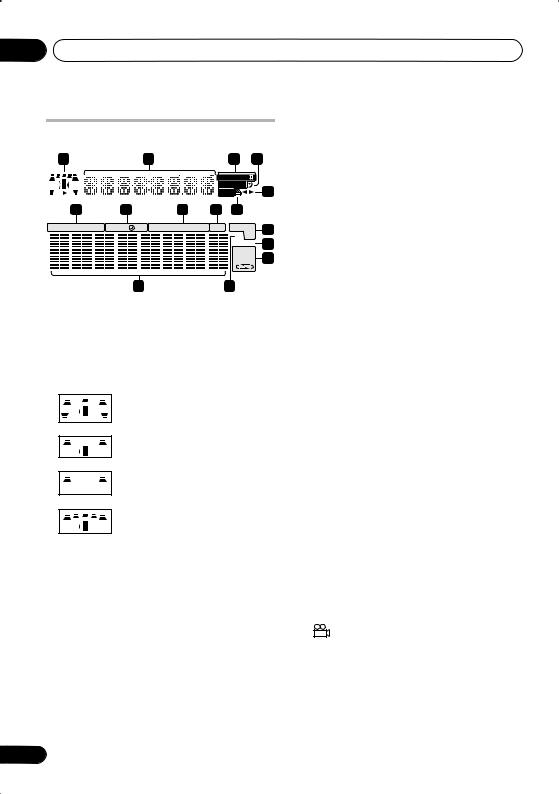
03 Controls and displays
Display
1 |
|
2 |
|
|
3 |
4 |
|
|
|
|
2PRO LOGIC |
|
|
SUB Wf |
|
|
|
2DIGITAL |
5 |
|
|
|
|
|
|
|
|
6 |
7 |
|
8 |
9 |
10 |
|
ECHO KEY KARAOKE L R WAKE–UP |
REC MONO STEREO |
TUNED B.CUT |
RDM RPT–1 |
11 |
||
|
|
|
|
|
SFC PGM |
12 |
|
|
|
|
|
96kHz |
|
|
|
|
|
|
REC MODE |
13 |
|
|
|
|
|
ASES REC |
|
|
|
14 |
|
|
15 |
|
1 Speaker and playback indicators |
|
|||||
The playback indicator ( |
) lights during playback, |
|||||
and the speaker indicators (EV7DVD/EV9DVD only) show which speakers are being used to output the current source. The illustrations below show some example displays.
5.1 channel surround sound
SUB
 Wf
Wf
SUB
 Wf
Wf
SUB
 Wf
Wf
Stereo (2.1 channel) sound
2 channel sound
5.1 channel surround sound with the Front Surround or Extra Power mode active
(When headphones are connected, none of the speaker indicators are lit.)
2Character display
3Format indicators
2 PRO LOGIC II (EV7DVD/EV9DVD only) –
Lights during Dolby Pro Logic II decoding.
2 DIGITAL – Lights during playback of a Dolby Digital signal.
DTS – Lights during playback of a DTS source.
4
Lights when the sleep timer is active.
14
5
Indicates the direction of tape playback.
6Karaoke indicators
ECHO – Lights when the Karaoke ECHO effect is selected.
KEY – Lights when the Karaoke pitch control is selected.
KARAOKE (Vocal cancel) – Vocals in the backing track are partially eliminated using EQ.
L – Left channel only. Use for tracks that have a vocal recorded in the right channel.
R – Right channel only. Use for tracks that have a vocal recorded in the left channel.
L R – Use to put a single-channel vocal track into the center of the mix.
7Timer indicators
WAKE-UP – Lights when the wake-up timer is set.
 – Lights when the wake-up timer is set and flashes when it activates.
– Lights when the wake-up timer is set and flashes when it activates.
REC – Lights when the record timer is set and flashes when the timer starts recording.
8Tuner indicators
MONO – Lights when FM mono reception is selected.
STEREO – Lights when a stereo FM broadcast is being received in auto stereo mode.
TUNED – Lights when a broadcast is being received.
9B.CUT
Lights when the beat cut mode has been switched to B.CUT 2 (for recording).
10
Lights during multi-angle scenes on a DVD.
11Playback mode indicators
RDM – Lights during random playback.
RPT-1 – RPT lights during repeat play (RPT- 1 lights during repeat one-track play).
PGM – Lights during program play.
En
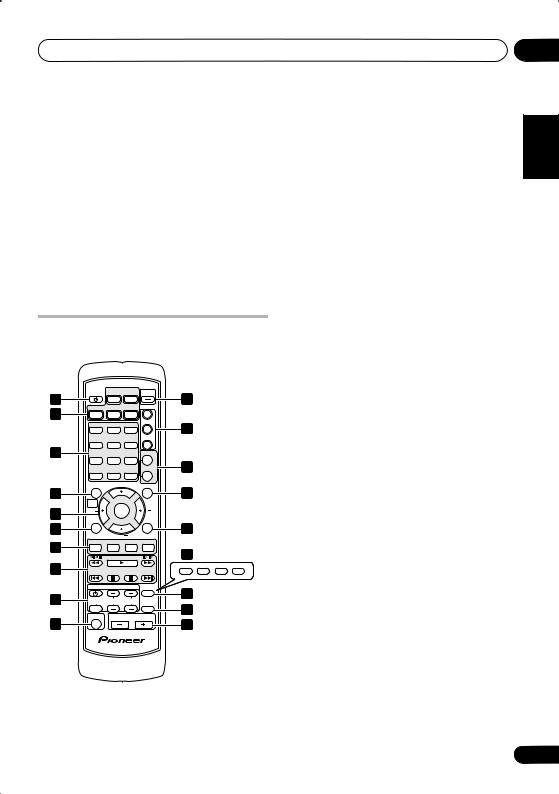
Controls and displays |
03 |
12 96 kHz
Lights when a 96 kHz source is detected (may not light if the source is copy–protected).
13Cassette deck indicators
REC MODE (EV7DVD/EV9DVD only) – Lights during normal/ASES recording to indicate that some sound settings can’t be adjusted.
ASES REC – Lights during ASES recording.
 – Indicates the reverse mode.
– Indicates the reverse mode.
14Level meter
15SFC
Lights when one of the Sound Field Control listening modes is selected.
Remote control
Illustration shows the EV7DVD/EV9DVD model
|
STANDBY |
|
TUNER |
X.BOOM |
|
|
|
1 |
/ON |
DVD/CD |
(FM/AM) |
11 |
|
|
|
|
|
|
|
|
|
||
2 |
USB |
TAPE |
LINE |
PLAY LIST |
|
|
|
|
|
|
1 |
|
|
|
|
|
PGM |
RPT |
RDM |
2 |
12 |
|
|
|
1 |
2 |
3 |
|
|
||
|
ST.MEMORY |
MONO |
3 |
|
|
|
|
3 |
4 |
5 |
6 |
|
|
|
|
AUDIO |
SUBTITLE |
ANGLE |
KARAOKE |
|
|
|
|
|
|
|
|
||||
|
7 |
8 |
9 |
|
13 |
|
|
|
TIMER |
ZOOM |
|
ECHO |
|
|
|
|
|
|
|
|
|||
|
CLEAR |
0 |
ENTER |
|
|
|
|
|
SYSTEM SETUP TUNE |
|
TOP MENU |
14 |
|
|
|
4 |
HOME |
|
|
MENU |
|
|
|
|
|
|
|
|
|
||
|
MENU |
|
|
|
|
|
|
5 |
ST |
ENTER |
ST |
|
|
|
|
TEST |
|
|
CH |
|
|
|
|
|
TONE |
|
|
LEVEL |
|
|
|
6 |
SOUND MODE |
TUNE |
|
RETURN |
15 |
|
|
|
|
|
|
|
|||
7 |
SFC |
SURROUND |
FRT.SURR |
EXT PWR |
|
|
|
|
|
|
|
16 EV5DVD only |
|||
|
|
|
|
|
|||
8 |
|
|
|
|
AUDIO |
SUBTITLE |
ANGLE ZOOM |
|
|
|
|
|
|
|
|
|
|
|
|
|
|
|
MUTE |
|
TV CONTROL |
|
DISPLAY |
1 |
2 |
3 |
|
9 |
INPUT |
CHANNEL |
VOLUME |
|
17 |
|
|
MUTE |
|
|
|
||||
|
|
|
18 |
|
|
||
|
SHIFT |
|
VOLUME |
|
|
|
|
10 |
|
|
|
|
|
||
|
|
|
|
19 |
|
|
|
1 STANDBY/ON
Switches the player on or into standby.
2Input source function select
Selects the source you want to listen to.
3Number buttons and SHIFT functions
The number buttons can be used for selecting tracks directly, the functions above the buttons are accessed by pressing SHIFT at the same time as the button.
PGM (SHIFT+1) – Use to program/play a program list (page 28).
RPT (SHIFT+2) – Selects a repeat play mode (page 27).
RDM (SHIFT+3) – Selects a random play mode (page 28).
ST.MEMORY (SHIFT+5) – Use for saving and listening to station presets (page 37).
MONO (SHIFT+6) – Press to listen to a stereo FM broadcast in mono (page 20).
AUDIO (SHIFT+7) (EV7DVD/EV9DVD only)
– Selects the audio channel or language (page 31).
SUBTITLE (SHIFT+8) (EV7DVD/EV9DVD only) – Selects a subtitle display (page 30).
ANGLE (SHIFT+9) (EV7DVD/EV9DVD only)
– Changes the camera angle during DVD multi-angle scene playback (page 31).
TIMER (EV7DVD/EV9DVD: SHIFT+CLEAR /
EV5DVD: SHIFT+9) – Use for setting and checking the clock (page 17) and the timers (page 40).
ZOOM (SHIFT+0) (EV7DVD/EV9DVD only)
– Changes the zoom level (page 31). CLEAR – Clears an entry.
ENTER – Selects menu options, etc.
4HOME MENU
Press to display (or exit) the on-screen menu for Initial Settings, Play Mode functions, etc.
SYSTEM SETUP (SHIFT+HOME MENU) Use to make various system and surround sound settings (page 48). Also used when automatically saving station presets when using the tuner (page 37).
5ENTER, TUNE & cursor control buttons
Navigates on-screen displays and menus. ENTER selects an option or executes a command.
English
Español Nederlands Italiano Français Deutsch
15
En

03 Controls and displays
6SOUND MODE
Accesses settings in the Sound menu, such as the tone controls (page 39).
TEST TONE (SHIFT+SOUND MODE)
(EV7DVD/EV9DVD only) – Press to output the test tone for speaker setup (page 21).
7Sound Field / listening mode buttons SFC – Selects sound modes or custom settings from the Sound Field Control (page 39).
SURROUND (EV7DVD/EV9DVD only) –
Selects a surround listening mode (page 23).
FRT.SURR (EV7DVD/EV9DVD only) – Switches on the Front Surround mode (page 24).
EXT PWR (EV7DVD/EV9DVD only) – Switches on the Extra Power mode (page 24).
DISPLAY (EV5DVD only) – Switches between information displays (page 31).
11 X.BOOM
Switches the bass boost on or off (page 39).
12 PLAY LIST buttons
Adds tracks to (during playback), or selects the playlist (while stopped) (page 29).
13KARAOKE controls
KARAOKE – Selects audio channels for karaoke (page 38).
ECHO – Changes the echo level on the karaoke mics (page 38).
/– Raises/lowers the pitch of the backing track (page 38).
14MENU
Displays the DVD menu (for Video CD/ Super VCDs, DivX video and WMA/MP3/ MPEG-4 AAC/JPEG discs, the Disc Navigator screen appears).
8 Playback controls |
TOP MENU (SHIFT+MENU) |
|
Displays the top menu of a DVD disc. |
||
– Starts/resumes playback. |
||
|
and |
– Use for reverse slow |
motion playback, frame reverse and |
|
reverse scanning. |
|
and |
/ – Use for forward slow |
motion playback, frame advance and forward scanning.
–Jumps to the next chapter or track.
–Jumps to the beginning of the current chapter or track, then to previous chapters/tracks.
–Pauses playback; press again to restart.
–Stops playback.
9TV CONTROL1 (EV7DVD/EV9DVD only)
–Switches the TV on or into standby.
INPUT – Switches the TV input. CHANNEL +/– – Selects channels. VOLUME +/– – Adjusts the TV volume.
10 SHIFT
Press to access the functions/commands written in green on the remote.
15RETURN
Press to return to a previous menu screen.
CH LEVEL (SHIFT+RETURN) (EV7DVD/ EV9DVD only) – Use to adjust the speaker level (page 21).
16DVD controls (EV5DVD only)
AUDIO – Selects the audio channel or language (page 31).
SUBTITLE – Selects a subtitle display (page 30).
ANGLE – Changes the camera angle during DVD multi-angle scene playback (page 31).
ZOOM – Changes the zoom level (page 31).
17DISPLAY (EV7DVD/EV9DVD only)
Switches between information displays (page 31).
18MUTE
Mutes the volume (page 39).
19 VOLUME
Adjusts the volume level.
 Note
Note
1 Refer to Using the remote to control your TV on page 17 to use these controls with your TV.
16
En
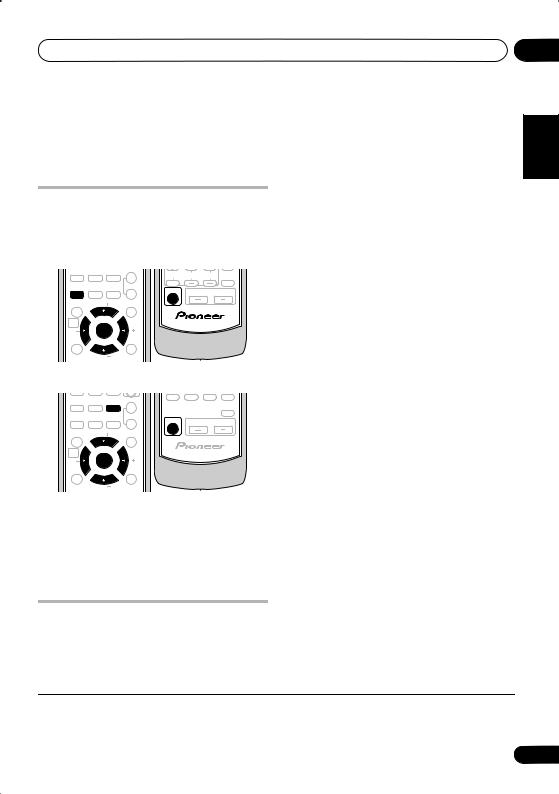
Getting started
Chapter 4
Getting started
Setting the clock
Setting the clock allows you to use the timer.1
1Press TIMER.
• EV7DVD/EV9DVD:SHIFT+CLEAR:
AUDIO SUBTITLE |
ANGLE |
KARAOKE |
|
|
|
|
INPUT |
CHANNEL |
VOLUME |
|
|||
7 |
8 |
9 |
MUTE |
|||
TIMER |
ZOOM |
|
ECHO |
|
|
|
|
SHIFT |
|
VOLUME |
|
||
CLEAR |
0 |
ENTER |
|
|
||
|
|
|
|
|||
SYSTEM SETUP |
TUNE |
|
TOP MENU |
|
|
|
HOME |
|
|
MENU |
|
|
|
MENU |
|
|
|
|
|
|
ST |
ENTER |
ST |
|
|
|
|
TEST |
|
|
CH |
|
|
|
TONE |
|
|
LEVEL |
|
|
|
SOUND MODE |
TUNE |
|
RETURN |
|
|
|
• EV5DVD: SHIFT+9: |
|
|
|
|||
|
|
TIMER |
KARAOKE |
|
|
|
7 |
8 |
|
|
|
|
|
9 |
|
|
|
MUTE |
||
|
|
|
1 |
2 |
3 |
|
|
|
|
ECHO |
|
|
|
CLEAR |
0 |
ENTER |
SHIFT |
|
VOLUME |
|
|
|
|
|
|||
SYSTEM SETUP |
TUNE |
|
TOP MENU |
|
|
|
HOME |
|
|
MENU |
|
|
|
MENU |
|
|
|
|
|
|
ST |
ENTER |
ST |
|
|
|
|
SOUND |
|
|
RETURN |
|
|
|
MODE |
|
|
|
|
|
|
TUNE
2If ‘CLK ADJ?’ isn’t in the display, select it with or , then press ENTER.
3Use / to set the hour. Press ENTER.
4Use / to set the minute then press
ENTER to confirm.
Using the remote to control your TV
1Switch on your TV.
2Find the name of the manufacturer of your TV in the Preset Code List on page 60.
Next to each manufacturer is one or more three digit codes. These tell the remote what kind of TV you have.
If the name of the manufacturer of your TV does not appear in the table, you won’t be able to set up this remote to control your TV.
3 Point the remote at your TV, hold down the CLEAR button, then enter the three digit code for your TV.
The remote transmits an on/off signal to the TV. If you’ve entered the correct code, your TV should switch off.
If your TV doesn’t turn off, repeat the procedure using the next code in the list until your TV switches off successfully. Once set, you can then use the individual TV controls shown below.
Button |
What it does |
|
Switches your TV on or into |
|
standby. |
|
|
CHANNEL +/– Changes the TV channel. |
|
|
|
VOLUME |
Adjusts the volume. |
|
|
INPUT |
Switches the TV’s input |
|
between the built in TV tuner |
|
and an external video source. |
|
|
EV7DVD/EV9DVD model only |
Using the on-screen displays |
|
You can set up the supplied remote to control |
||
For ease of use, this system makes extensive |
||
your TV using the TV CONTROL buttons.2 |
||
use of graphical on-screen displays (OSDs). |
||
|
 Note
Note
1The default setting is 12-hour format. See Optional system settings on page 48 to change it.
2• The default setting is for a Pioneer TV.
• Note that there are also cases where the codes listed for a manufacturer in the Preset Code List may not work for your TV.
04
English
Español Nederlands Italiano Français Deutsch
17
En

04 Getting started
All the screens are navigated in basically the same way, using the cursor buttons ( , , ,) to change the highlighted item and
pressing ENTER to select it.1
 Important
Important
•Throughout this manual, ‘Select’ means use / / / to highlight an item onscreen, then press ENTER.
Button What it does
HOME Displays/exits the on-screen display
MENU
Changes the highlighted menu item
ENTER Selects the highlighted menu item
RETURN Returns to the main menu without saving changes
 Tip
Tip
•The button guide at the bottom of every OSD screen shows you which buttons you’ll need to use for that screen.
Playing discs
The basic playback controls for DVD, CD, Video CD/Super VCD, DivX video and WMA/MP3/ MPEG-4 AAC discs are covered here. Further functions are detailed in chapter 7.
1 If the player isn’t already on, switch it on.
Load a disc with the label side facing up, using the disc tray guide to align the disc (if you’re loading a double-sided DVD disc, load it with the side you want to play face down).
3 Press (play) to start playback.
If you’re playing a DVD or Video CD/Super VCD, a menu may appear. See DVD-Video disc menus on page 19 and Video CD/Super VCD PBC menus on page 19 to navigate these.
If you loaded a disc containing JPEGs, a slideshow will start. See Playing a JPEG slideshow on page 25 for more on this.
•If a disc contains a mixture of DivX video and other media file types (MP3, for example), first select whether to play the DivX video files (DivX) or the other media file types (MP3 / WMA / MPEG-4 AAC /
JPEG) from the on-screen display.
4 Adjust the volume.
Use the VOLUME +/– control.
Basic playback controls
The following table shows the basic controls on
the remote for playing discs2. You can find other playback features in the chapter 7.
If you’re playing a disc with video, also turn on your TV and make sure that it is set to the correct video input.
2 Press DVD OPEN/CLOSE on the front panel to load a disc.
Button What it does
Starts/resumes normal playback.
• If the display shows RESUME or LAST MEM playback starts from the resume or last memory point (see
Resume and Last Memory below).
Pauses/unpauses a disc.
 Note
Note
1The screen saver will appear after five minutes of inactivity.
2You may find with some DVD discs that some playback controls don’t work in certain parts of the disc.
18
En

Getting started |
04 |
Button What it does
Stops playback or cancels the resume function (if the display shows RESUME).
Press to start fast reverse scanning.
Press to start fast forward scanning.
Skips to the start of the current track or chapter, then previous tracks/chapters.
Skips to the next track or chapter.
Numbers Use to enter a title/chapter/track number. Press ENTER to select.
•If the disc is stopped, playback starts from the selected title (for DVD) or track (for CD/Video CD/Super VCD).
•If the disc is playing, playback jumps to the start of the selected title (VR mode DVD-R/RW), chapter (DVDVideo) or track (CD/Video CD/Super VCD).
Resume and Last Memory
When you stop playback of a disc, RESUME shows in the display indicating that you can resume playback from that point.
With DVDs and Video CD/Super VCDs, even if
ejected, the play position is stored in memory.1 The next time you load the disc, the display shows LAST MEM and you can resume playback.
If you want to clear the resume point, press (stop) while RESUME is displayed.
DVD-Video disc menus
Many DVD-Video discs contain menus from which you can select what you want to watch.
Sometimes DVD-Video menus are displayed automatically when you start playback; others only appear when you press MENU or TOP MENU (SHIFT+MENU).
Button |
What it does |
TOP MENU Displays the ‘top menu’ of a DVD (SHIFT+MENU) disc—this varies with the disc.
MENU Displays a DVD disc menu—this varies with the disc and may be the same as the ‘top menu’.
Moves the cursor around the screen.
ENTER Selects the current menu option.
RETURN Returns to the previously displayed menu screen.
Numbers Highlights a numbered menu option (some discs only). Press ENTER to select.
Video CD/Super VCD PBC menus
Some Video CD/Super VCDs have menus from which you can choose what you want to watch. These are PBC (Playback control) menus.
You can play a PBC Video CD/Super VCD without having to navigate the PBC menu by starting playback using a number button to select a track, rather than the (play) button.
Button |
What it does |
RETURN |
Displays the PBC menu. |
|
|
Numbers |
Selects numbered menu options. |
|
Press ENTER to select. |
|
|
|
Displays the previous menu page |
|
(if there is one). |
|
|
|
Displays the next menu page (if |
|
there is one). |
|
|
English
Español Nederlands Italiano Français Deutsch
 Note
Note
1• The Last Memory function may not work with some discs.
• For DVD-Video discs (except VR mode DVD-R/RW), the player stores the play position of the last five discs.
19
En
